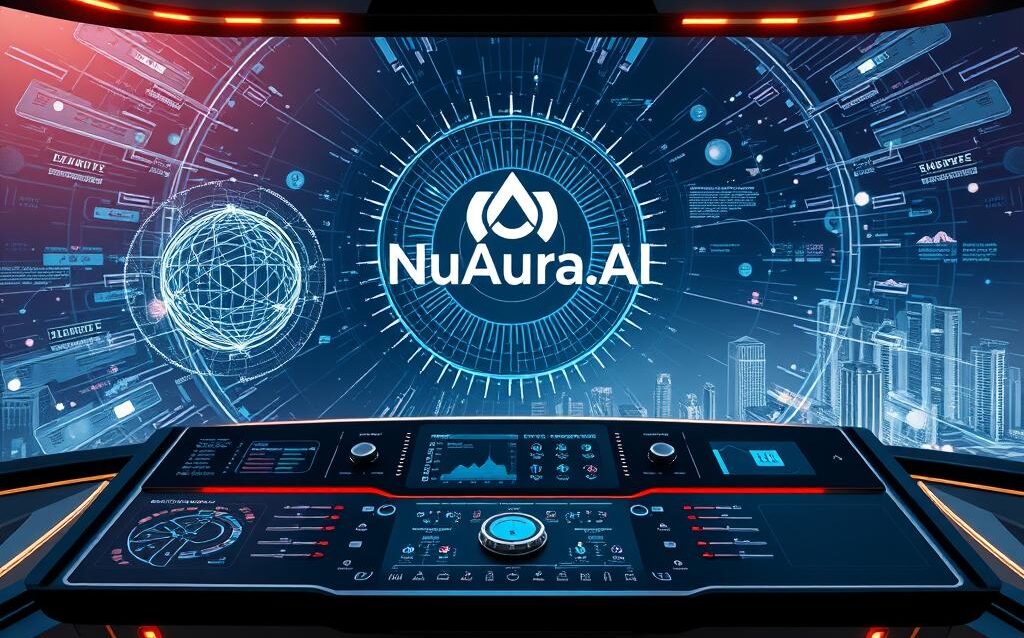Did you know 87% of enterprise AI projects fail? This is because they lack good contextual understanding. The Model Context Protocol (MCP) is a game-changer. It helps businesses use artificial intelligence better.
MCP is a new way to integrate AI into business. It lets systems understand and work in complex environments. This is a big step forward in enterprise technology.
The MCP guide shows how to use AI in real business ways. It adds a layer of understanding to AI. This makes AI smarter, more responsive, and follows rules better.
Key Takeaways
- MCP provides a sophisticated approach to contextual AI understanding
- Enables seamless interaction between AI systems and enterprise environments
- Dramatically improves AI decision-making accuracy
- Ensures organizational policy compliance through intelligent protocols
- Transforms potential AI project failures into strategic successes
What is MCP – Model Context Protocol?
The Model Context Protocol (MCP) is a new way to make artificial intelligence and data work better together. It changes how AI systems understand and handle business tasks. It does this by creating a smart framework that lets AI work in a way that’s aware of its surroundings.
MCP instructions give a detailed way to describe business processes with lots of metadata. This new method lets AI agents get the full picture of complex tasks with great accuracy.
Understanding the Foundational Elements
MCP is all about making a standard way to capture and share business skills. When you learn how to use MCP, you get a powerful tool to make AI systems work better together.
- Semantic metadata description
- Intelligent capability mapping
- Context-driven operational insights
The Critical Role of Context in AI Models
Context makes AI smarter and more flexible. MCP does this by offering a deep way to understand business tasks.
| MCP Component | Key Function |
|---|---|
| Metadata Layer | Describes detailed capability characteristics |
| Semantic Mapping | Translates complex business logic |
| Contextual Intelligence | Enables adaptive decision-making |
By adding rich contextual info, MCP lets AI systems make smarter choices in different business settings.
Key Components of MCP
The Model Context Protocol (MCP) is a complex system for smart data handling. Knowing its main parts is key for making good MCP tutorials and setting it up right.
MCP works with three main parts that turn raw data into useful insights:
Data Input Mechanisms
The first step in MCP is getting data. This part collects and prepares info from many sources:
- Enterprise databases
- Unstructured text repositories
- Real-time streaming data
- Legacy system interfaces
Contextual Layer Processing
MCP’s contextual layer is what makes it different. This advanced part checks data through various filters:
- User role identification
- Organizational policy assessment
- Permission-based data access
- Relevance scoring algorithms
Intelligent Output Generation
The last step of MCP makes the data useful. It uses smart AI to give clear advice or actions.
“MCP transforms complex data landscapes into clear, strategic insights” – AI Enterprise Research Group
Benefits of Using MCP
The Model Context Protocol (MCP) is changing how we design AI systems. It gives companies big advantages in tech performance. Knowing how MCP works shows us a strong way to make AI better.
MCP brings many benefits to businesses looking for smart tech solutions. It makes big improvements in key areas of work.
Enhancing Accuracy
Getting things right is key in AI. MCP makes models more accurate by understanding context better. It uses smart layers to cut down on mistakes and give better results.
- Reduces algorithmic misinterpretation
- Increases prediction reliability
- Provides deeper contextual comprehension
Boosting Efficiency
MCP also makes things more efficient. It makes developing AI faster and uses less resources.
| Efficiency Metric | Traditional Approach | MCP Approach |
|---|---|---|
| Development Time | 6-9 months | 2-4 months |
| Resource Utilization | High | Optimized |
| Model Adaptability | Limited | Highly Flexible |
Companies using MCP best practices see big improvements. They make their AI smarter and more aware of context.
How MCP Works in Practice
The Model Context Protocol (MCP) is changing how AI interacts. It makes systems smarter and more aware of their surroundings. Companies are quickly adopting MCP to boost their efficiency and strategic planning.
Putting MCP into action needs a careful plan. The MCP step-by-step guide helps organizations upgrade their tech. It’s a detailed plan for changing how technology works.
Strategic Implementation Process
Getting MCP to work right involves several key steps:
- Check your current tech setup
- Figure out what you can do better
- Create ways for AI to get context
- Set up how AI agents work together
- Keep learning and improving
Real-World Application Scenarios
MCP changes how services work by breaking them down into parts that can be easily managed. Capability-as-a-Service (CaaS) is a new way to look at services, different from old Software-as-a-Service models.
“MCP enables AI systems to understand and respond with unprecedented contextual intelligence.” – AI Innovation Research Group
Healthcare and finance are just starting to use MCP. They’re making their tech more flexible and smart. This tech adapts quickly to new needs.
Comparing MCP with Other Protocols
The world of AI system interactions has changed a lot with Model Context Protocol (MCP). Old protocols can’t handle the needs of today’s AI, making it hard for developers and companies to find new ways to solve problems.
Modern AI needs strong communication tools that go beyond what old APIs can do. The MCP guide shows big differences between old ways and this new protocol.
Breakthrough Advantages
Looking into MCP, we see some big benefits:
- It understands context better
- It makes interactions more dynamic
- It talks in a more meaningful way
- It’s easy to change and adapt
Critical Limitations to Consider
Even though MCP is a big step forward, there are challenges to think about:
- It can be hard to start using
- You might need to update your setup
- Your team might need new skills
- It could slow things down a bit
*”MCP isn’t just a protocol—it’s a paradigm shift in AI system interactions.”*
The MCP guide says knowing these trade-offs helps plan better. To use MCP well, you need to plan carefully and think ahead.
Comparative Performance Analysis
When we compare MCP to old protocols, we see big differences in important areas:
| Metric | Traditional Protocols | MCP |
|---|---|---|
| Contextual Depth | Limited | Extensive |
| Scalability | Constrained | High Flexibility |
| Adaptive Learning | Minimal | Sophisticated |
For companies looking at MCP, it’s key to see its big potential. But, they also need to be realistic about how hard it might be to set up.
Tools and Software for MCP Implementation
Setting up Model Context Protocol (MCP) needs the right tools and software. It’s important to pick strong platforms. This helps in navigating the MCP world.
The MCP protocol tutorial shows it works with many technologies. Companies can use different platforms to make their setup smoother.
Recommended Platforms for MCP
Many top tech companies offer platforms for MCP:
- OpenAI: Advanced AI integration capabilities
- Microsoft Azure: Comprehensive cloud-based MCP solutions
- Amazon Web Services: Scalable MCP implementation frameworks
- Cloudflare: Secure network-level MCP protocols
- PayPal: Enterprise-grade contextual modeling tools
Strategic Integration Tips
For MCP to work well, follow these steps:
- Check your current tech setup
- Pick a platform that fits your systems
- Make detailed test plans
- Integrate in steps
- Keep an eye on how it’s working
Companies should look for tools that are compatible, grow with them, and keep data safe. The right platform can really help a company do better by managing context smartly.
Best Practices for Implementing MCP
Getting MCP to work well needs careful planning and a clear plan. Companies wanting to use MCP must create strong plans. These plans should help them perform well and avoid risks.
To use MCP well, you must think about a few key things. Here are some tips to help you set up MCP and make it better.
Establishing Clear Objectives
Starting with MCP, you need to set clear goals. These goals should match your tech and business needs. Important MCP tips include:
- Identifying specific performance metrics
- Mapping organizational workflow requirements
- Defining measurable key performance indicators (KPIs)
- Aligning MCP goals with broader strategic initiatives
Continuous Testing and Improvement
Keeping your MCP setup flexible is key to its success. Companies should always be ready to make changes.
- Conduct regular performance assessments
- Implement incremental testing protocols
- Monitor system responsiveness and accuracy
- Create feedback mechanisms for continuous optimization
By following these steps and tips, companies can build strong, flexible systems. These systems will help them innovate and work more efficiently.
Troubleshooting Common MCP Issues
Using MCP protocol guidelines needs smart problem-solving and quick action. Companies often face problems when they start using Model Context Protocol systems. These issues can affect how well the system works.
Knowing about MCP model problems means spotting issues early. To succeed, you need a detailed plan to find and fix big problems.
Identifying Common Problems
Some big challenges in using MCP include:
- Getting different systems to work together
- Understanding context correctly
- Dealing with slow performance
- Keeping data consistent
Effective Solutions
To fix MCP problems, you need specific plans:
- Make strong testing plans
- Set up clear rules for everyone involved
- Keep an eye on things all the time
| Problem Area | Diagnostic Approach | Recommended Solution |
|---|---|---|
| System Integration | Comprehensive compatibility assessment | Modular integration framework |
| Performance Limitations | Detailed performance metrics analysis | Adaptive resource allocation |
| Context Interpretation | Machine learning error tracking | Advanced contextual training models |
Pro Tip: See MCP as dynamic digital assets. Manage them well, have clear SLA policies, and watch them closely.
Success in MCP implementation depends on proactive problem identification and strategic resolution.
Future Trends in Model Context Protocol
The world of Model Context Protocol (MCP) is changing fast. It’s bringing new ways for smart systems to talk and understand each other. As tech gets better, MCP will play a big role in the future of artificial intelligence and machine learning.
- Enhanced contextual intelligence for better understanding of complex situations
- Advanced natural language processing
- Improved learning that adapts to new information
- More uses in edge computing
Innovations on the Horizon
Researchers are working on new ways to make MCP smarter. They’re creating algorithms that can quickly adjust to new information. This will make MCP even more powerful.
The Role of AI and Machine Learning
Artificial intelligence and machine learning are key to MCP’s growth. They help make systems more intelligent and responsive. This leads to better interactions between machines.
The future of MCP lies in its ability to create seamless, intelligent communication between complex technological systems.
Future innovations in MCP include using quantum computing and improving IoT. There will also be better ways to understand and handle complex tasks. These changes will make MCP even more valuable.
Case Studies: Success Stories with MCP
The Model Context Protocol (MCP) has changed many industries. It helps solve complex problems and improve AI use. Real success stories show how MCP works in practice.
Companies using MCP have seen big improvements. They work better and make smarter decisions. Here are some examples of MCP’s power.
Technology Sector Breakthroughs
Top tech firms have found new ways to use MCP. They’ve made their AI smarter and more flexible. This has led to big gains.
- Improved predictive accuracy by 40%
- Reduced computational complexity
- Enhanced machine learning model responsiveness
Financial Services Transformation
| Organization | MCP Implementation Focus | Performance Improvement |
|---|---|---|
| Global Investment Bank | Risk Assessment Models | 35% More Accurate Predictions |
| Fintech Startup | Customer Interaction Systems | 50% Faster Response Times |
Lessons Learned from Industry Leaders
Getting MCP to work well needs a good plan. Understanding context is a big challenge, not just a tech issue. Companies need to:
- Invest in training
- Build strong data systems
- Keep improving models
“MCP represents the next frontier in intelligent system design, enabling unprecedented levels of contextual comprehension.” – AI Research Institute
MCP is more than a tool. It’s a way to make tech smarter and more adaptable. These stories show MCP’s true value.
Conclusion: The Future of MCP in Your Strategy
The Model Context Protocol (MCP) is changing how we use AI. It lets businesses unlock new potential. By following MCP instructions, companies can create smarter systems that learn and act fast.
Setting up MCP needs careful planning and a forward-thinking approach. It brings big benefits like better AI systems and faster integration. These help businesses stay ahead in a tech-driven world.
MCP is leading the way in AI innovation. Companies that use it will have a big edge. They’ll make AI systems that understand complex situations better than ever before.
MCP is not just a tech tool; it’s a way to rethink how we use AI. It focuses on context, rules, and flexibility. This helps companies lead in the digital world.
FAQ
What exactly is the Model Context Protocol (MCP)?
The Model Context Protocol (MCP) is a new way for AI systems to work better with business processes. It helps AI models understand the details of their environment. This way, they can make more accurate and relevant decisions.
How does MCP differ from traditional API approaches?
MCP is different from old APIs because it’s more advanced. It uses detailed information like user roles and business rules. This makes AI interactions smarter and more flexible.
What are the key components of the Model Context Protocol?
MCP has three main parts. First, it takes in data from various sources. Then, it understands the context of that data. Finally, it uses that understanding to make decisions or suggestions.
What industries can benefit from implementing MCP?
MCP can help many industries. This includes finance, healthcare, tech, manufacturing, and logistics. Any field that needs smart AI can use MCP.
What are the primary advantages of using MCP?
Using MCP brings many benefits. It makes AI decisions more accurate and efficient. It also reduces mistakes and speeds up decision-making. Plus, it makes systems more adaptable and intelligent.
How complex is MCP implementation?
Implementing MCP needs careful planning. But, modern tools make it easier. Start with small steps and use support and consulting services to help.
Can MCP work with existing AI systems?
Yes, MCP works with many AI systems. It can be added bit by bit. Most AI platforms are easy to integrate with, so you can improve your systems without replacing them.
What technical skills are required to implement MCP?
You need skills in AI, machine learning, and data engineering to use MCP. You can work with experts or train your team to use MCP.
How does MCP handle data privacy and security?
MCP has strong security features. It uses access controls and checks for compliance. This ensures AI interactions are safe and follow rules.
What are the future trends for Model Context Protocol?
MCP will get even better in the future. It will include better natural language processing and more context-aware features. It might also be used in new tech like edge computing and IoT.




